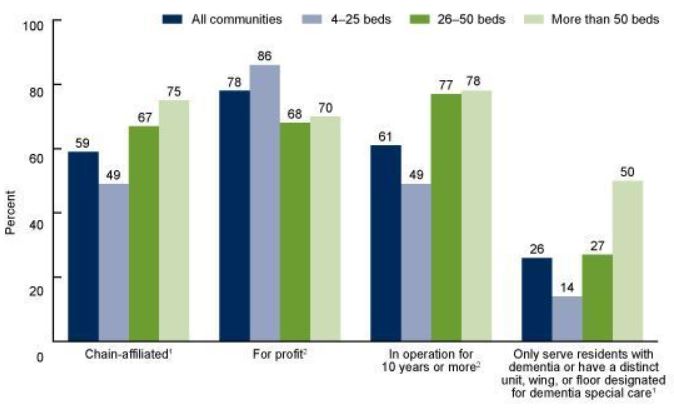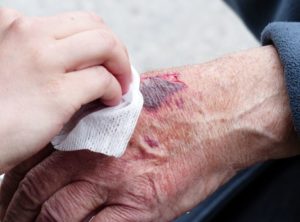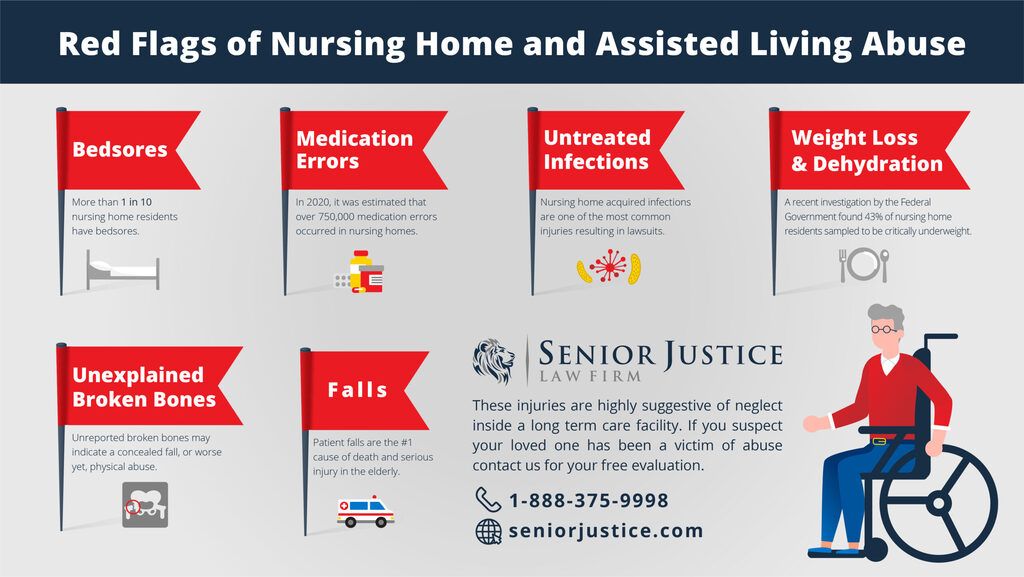Understanding Memory Care Liability Claims
Contemplating filing a lawsuit against a Memory Care facility for abuse, neglect or negligence? Our skilled and experienced memory care abuse attorneys can help you understand the legal process behind a memory care lawsuit for injury or wrongful death.
Falls, broken bones, elopements, medication errors, and wrongful death injuries deserve investigation.
At Senior Justice Law Firm, we narrowly focus on obtaining justice for families impacted by long term care facility negligence. This is all we do. Contact us today so we can answer your questions regarding a potential memory care negligence case.
Free Memory Care Lawsuit Consultation: 888-375-9998
What is a Memory Care Unit in an Assisted Living Facility?
 Memory care units are a more recent addition to many nursing homes and long-term care facilities. Also referred to as “special care units” or “Alzheimer’s care units,” memory care units are intended to benefit older folks who are struggling with dementia, confusion, and cognitive impairment.
Memory care units are a more recent addition to many nursing homes and long-term care facilities. Also referred to as “special care units” or “Alzheimer’s care units,” memory care units are intended to benefit older folks who are struggling with dementia, confusion, and cognitive impairment.
These individuals require a higher level of skilled care than alert and oriented residents. Many need to be in skilled nursing facilities. However, entrepreneurial assisted living companies have eagerly entered the dementia and Alzheimer’s “business” by creating memory care units in their facilities. Memory care units are meant to offer these people with specialized attention suited to their niche of needs. Unfortunately, that is not always the case. Our attorneys commonly see memory care units that lack staff, which results in falls, injuries, nursing mistakes, and wrongful death.
Some memory care units are set up communally like a nursing home, while others offer private spaces. They may function as standalone locations, but more often, they are a wing or branch of an existing assisted living facility or nursing home.
How is Memory Care Different from a Nursing Home?
Treatment at a memory care differs from the typical treatment provided for residents in a nursing home. The staff who work in a memory care unit are supposed to undergo specific dementia training—though whether this actually occurs is debatable depending upon the location. Supervision is provided 24 hours per day, and many memory-specific activities are available to help to slow mental decline and stimulate the mind. These activities may include anything from music to arts and crafts or games.
Glaringly, if the memory care is located in an assisted living facility, this allows the ownership/corporation to completely avoid complying with state and federal nursing home regulations. This means, even though the unit is marketed as specializing in memory care for dementia patients, the ALF is not staffed like a nursing home and is not subject to the same scrutiny a nursing home would be.
This is the most common cause of memory care injuries — when a facility keeps a high acuity, high needs resident instead of doing the right thing and discharging them to a nursing home.
How is Memory Care Different from an Ordinary Assisted Living Facility?
In an assisted living facility, the staff may not be trained to effectively tackle each individual resident’s mental acuity struggles. Memory care locations specialize in this type of treatment and can provide tasks and engagement that are directly targeted to the mind and slowing the progression of dementia.
As mentioned above, assisted living facilities have far more lax staffing requirements, when compared to nursing homes. This means a company can staff like an ALF but market the care levels of a nursing home, allowing the facility to maximize profits while reducing staff overhead.
Our memory care negligence lawyers find this to be a recipe for disaster. As always, in the end, it is the vulnerable residents who lose.
Why is Memory Care such a Growing Trend in the Long Term Care Industry?
 Memory care facilities represent the fastest growing sector in the long term care industry. Because of this, the for profit companies that run nursing homes and ALF’s have flocked to the memory care space.
Memory care facilities represent the fastest growing sector in the long term care industry. Because of this, the for profit companies that run nursing homes and ALF’s have flocked to the memory care space.
Across the U.S. our memory care abuse attorneys see new facilities springing up. While nursing home bed occupancy has remained consistent, assisted living memory care bed numbers have skyrocketed.
The reason why this is happening is these companies are making a fortune pushing memory care to families.
Why is memory care so profitable? Because it is an easy sell to families. Memory Care operators convince a family that their loved one will receive nursing home levels of care, while understaffing the facility and pocketing huge profits.
Selling Memory Care Over a Nursing Home
Memory care is an easy sell to families. A smooth talking facility representative sits down with your family and convinces you that you do not want to put Mom in a nursing home. Instead, wouldn’t it be better to keep her comfortable in the assisted living facility’s memory care unit? After all, they specialize in memory care (dementia, Alzheimer’s), so they must be able to handle Mom’s cognitive loss, right?
Wrong. All too often, we see memory care facilities promising the moon. The reality is, unless the memory care is located inside a skilled nursing facility, the level of care is not equal to that of a skilled nursing facility. There is simply not enough staff.
Memory Care Negligence Statistics
It appears that memory care units in assisted living facilities are just another opportunity for the ALF to keep high-paying residents in house.
In recent years, the assisted living community has seen a surge in the number of memory care facilities across the nation. This is currently the fastest growing sector of long-term care. The reason for this is unfortunately primarily driven not by an increasing need and ability to provide for the unique needs of dementia patients, but rather as a simpler and more effective way to make a profit for long-term care facilities.
The National Center for Assisted Living, a primary authority on the current state of nursing home care in America, recently released statistics that clarify just how prevalent memory care has become.
The United States is currently home to approximately 30,200 assisted living communities nationwide. Of those, nearly 40% (or more than 12,000 locations) currently offer programs specifically targeting memory care and patients with Alzheimer’s or dementia. A whopping 10% of all existing communities only serve residents with dementia, and approximately 12% of all assisted living facilities have expanded to include a wing for memory care in their building(s). Most importantly, these memory care residents are three times as likely to suffer falls, injuries, and adverse medical incidents.
One of the greatest challenges faced in memory care units is elopement, or residents who wander out of the facility due to a reduction in mental acuity over time. Memory care locations tend to specifically advertise the safety of their building in preventing elopement when compared to standard nursing homes, but the reality is that up to 24% of patients who move into a facility for dementia care still wander.
Technology is currently in development and rolling out quickly to help combat this issue. GPS systems and geo-fencing are in the works, but memory care units are not obligated to utilize these tools if they do not want to spend the money on them—and for many, the primary driver for operating the facility is profit.
Again, the root cause of wandering, unsupervised ambulation, unassisted bathroom trips, and generalized falls in memory care facilities is understaffing. This is a conscious, company decision, made at the top, which directly jeopardizes patient safety. This is a profits-before-people decision that should not be tolerated.
The Issue with Memory Care
As memory care facilities continue to emerge across the nation, problems have been consistent to follow. A profit-driven mindset has infiltrated the field, and this attitude leads to an unacceptable standard of care. “A head in every bed” attitude with skeleton staff numbers is a recipe for disaster.
The Alzheimer’s Association noted to McKnights that “Many memory care units do not have defined levels of care based on the resident’s/patient’s stage of Alzheimer’s.” This can quickly become an issue for residents, as they may be kept at a memory care facility when they should be referred on to more advanced care in a skilled nursing home. This has generated a trend of keeping high-acuity patients in memory care units simply to profit off of them.
Many high-acuity residents who enter memory care units do so either through private pay, private insurance, or with Medicare, which pays more than Medicaid. This leads to many facilities electing to keep these high-profit, high-acuity individuals solely for the sake of money rather than referring them on to other facilities that may suit their needs better.
Greedy assisted living companies keeping residents solely based on their good insurance is becoming the norm, and this standard is unacceptable.
Common Memory Care Lawsuit Injuries
 A number of lawsuits have been filed against memory care units across the country for mistreatment of residents and for failure to send high acuity residents to nursing homes when the memory care unit could no longer safely care for the resident. Meridian Senior Living and 45 adult care locations throughout the state of North Carolina have recently been subjected to a suit in the amount of more than $60 million for allegedly defrauding Medicaid.
A number of lawsuits have been filed against memory care units across the country for mistreatment of residents and for failure to send high acuity residents to nursing homes when the memory care unit could no longer safely care for the resident. Meridian Senior Living and 45 adult care locations throughout the state of North Carolina have recently been subjected to a suit in the amount of more than $60 million for allegedly defrauding Medicaid.
According to the lawsuit, the special care unit—another term for a memory unit—was not appropriately staffed, but Meridian Senior Living billed Medicaid for the maximum amount each month anyway. If true, this is a profit-driven motive to benefit from the facilities’ memory care units in order to make money, all while intentionally understaffing the facility.
Similarly, the National Center for Assisted Living is monitoring developments nationwide regarding the use of antipsychotics in memory care wards. Some sources are actively seeking to ban the use of antipsychotics after investigations unearthed a disturbing trend; in memory care units, off-label use of these drugs is becoming increasingly common, likely as a way for staff to cope with having inadequate staff levels.
Shockingly, many memory care units dope up residents to keep them in a near vegetative state because it is a cheaper solution than hiring more staff. Excessive use of antipsychotics in dementia patients has been shown to have a profoundly negative effect on residents’ lives, and shows the true nature of many of these Memory Care units. This is another example of putting profits ahead of the needs of the residents themselves.
Antipsychotic use in this manner can result in a number of injuries, such as falls and fractures, hospitalization, and even death. This and other factors lead to an increasing trend in negligence and abusive injury at memory care units.
Common memory care injuries that result in litigation handled by our memory care abuse attorneys include:
Memory Care Falls Resulting in Fractures
One of the most common injuries that residents suffer in memory care units and assisted living facilities is frequent falls. While it is true that some falls are entirely accidental and could never have been prevented, any location that cares for the elderly is required to do their due diligence in removing trip hazards and otherwise mitigating fall risk. This can be achieved by lowering doorframe divides, promptly cleaning up slippery or wet floors, or even using beds with rails so that residents cannot easily roll out on accident.
Additionally, by their nature, demented memory care residents are prone to wandering. They cannot be instructed to stay in bed and use their call bell. Their underlying disease prevents them from being able to be educated on this. Therefore, it is the legal duty of the memory care facility to hire enough staff to keep an eye on the resident and prevent them from wandering and suffering a fall.
Falls can result in broken bones and a number of other serious injuries. Many falls are a result of memory care facilities failing to properly monitor residents or reduce their fall risk, which means they are liable for injuries such as brain bleeds (subdural hematomas) that residents receive when they fall in the memory care ward.
Elopement From the Memory Care Facility
Elopement, or wandering away from a memory care unit, is becoming a more common issue in memory care facilities. In the last few years, McKnights has noted a number of incidents, such as one resident who left a facility that did not lock its doors and later fell while walking around in the dark outside, fracturing their hip and experiencing a head injury.
Another occurrence saw one resident smash a window, crawl out of his room, and wander into a field across the parking lot from his facility. The temperature was below freezing, and he eventually collapsed and passed away before he was found.
In a separate instance, construction workers located one resident in a garbage bin behind an assisted living facility.
Memory care units are particularly susceptible to this sort of behavior, because residents may not have the cognitive awareness to remember where they are, why they are there, and that they should remain there. For this reason, MCUs that do not implement sufficient deterrents against elopement can be held liable for negligence.
Simply put, elopement from a memory care facility is never acceptable and almost always grounds for a memory care liability lawsuit.
Common suggestions for preventing elopement and doing due diligence to keep residents safe include creating an internal alert system to quickly initiate a response if a resident is missing or instructing staff to remain in the area of possible exits. Staff should also check on the whereabouts of all patients multiple times during their shift, and electronic equipment such as video cameras and bed or door alarms can be helpful.
Physical and Sexual Assault, by Staff or Other Residents inside Memory Care
As difficult as it may be to imagine that physical and sexual assault occurs in assisted living facilities, it is actually more common than one might think. In memory care units specifically, such incidents are rarely reported, because many residents struggle with cognition and memory and may not recall that the incident happened or may not be able to effectively communicate what occurred.
Another contributing factor to physical and sexual abuse in memory care units is rampant understaffing. When staff are strained by excessive workloads and caring for too many patients, they may lash out as a result of stress and fatigue. This is not an acceptable reason—no explanation for abuse and negligence is acceptable—but it is a common occurrence nonetheless.
Other residents may also pose a problem. If neighbors are unable to remember where they are or who they are due to issues related to dementia, they may behave in inappropriate ways with other residents. Similarly, facilities that have issues with elopement and allowing residents to wander also tend to have more issues with physical and sexual assault.
Whether perpetuated by staff or by another resident, physical or sexual abuse inside a memory care wing is completely unacceptable.
Memory Care Bedsores
One of the most frequent consequences of the understaffing that is common in memory care units is the occurrence of bed sores. These ulcer-like injuries appear on the skin as a result of a resident lying in one position for an extended period of time without moving. The pressure that builds up in areas like the shoulders and tailbone that are supporting the person’s full body weight deteriorates the skin, leading to bedsores.
It takes time to develop a deep memory care pressure sore, like a stage 3, stage 4, or unstageable wound.
Bed sores are rarely the result of a medical condition; they are almost always caused by neglect.
They are simple to prevent: staff need only to help the resident shift their body weight slightly every few hours. However, because memory care understaffing is so common, this simple task is often neglected. Left untreated, bedsores can grow and deepen until they reach the bone, exposing the resident to seriously and potentially fatal infections such as sepsis and MRSA.

Free Memory Care Lawsuit Evaluation with our Skilled and Compassionate Attorneys
At Senior Justice Law Firm, we want to be your family’s memory care negligence attorneys.
If you believe that your loved one has suffered from abuse or neglect in a memory care unit or an assisted living facility, you may be overwhelmed about what to do next. Senior Justice Law Firm would be happy to assist you in figuring out what your next best steps should be.
Contact our compassionate and experienced law firm to discuss your situation in a consultation with one of our experienced memory care abuse and neglect attorneys free of charge. Please be sure when you live chat or call our office that you share as much case facts as possible with our receptionist. This way, we will have the necessary information to determine if we can help you achieve justice.
Our firm mission is to end the systemic cycle of elder abuse in long term care facilities. We cannot continue to allow these for-profit companies to get away with this, unpunished. We want to help you and your family seek justice against abusive memory care facilities while receiving the compensation that you deserve.
Contact us today to see how we can help.

Senior Justice Law Firm; Memory Care Abuse & Neglect Attorneys
Q. What is a Memory Care facility?
A. Recently, savvy assisted living facility corporations realized that they were losing much of their residents due to an increase in their dementia. ALF companies realized that they could keep higher acuity patients if they formed Memory Care wings or Memory Care units. These areas of the facility are specifically created for residents suffering from dementia or Alzheimer’s Disease. This means these memory care units owe a higher duty of care to resident’s when compared to traditional assisted living facilities.


